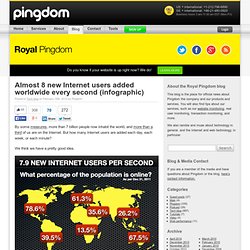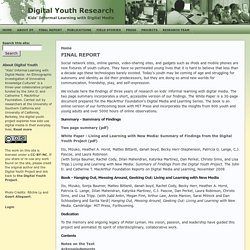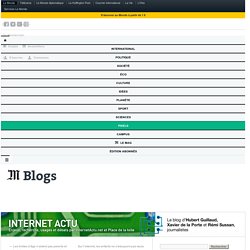

New Mobile Obsession: U.S. Teens Triple Data Usage. Teens have officially joined the mobile Data Tsunami, more than tripling mobile data consumption in the past year while maintaining their stronghold as the leading message senders.

Using recent data from monthly cell phone bills of 65,000+ mobile subscribers who volunteered to participate in the research, Nielsen analyzed mobile usage trends among teens in the United States. In the third quarter of 2011, teens age 13-17 used an average of 320 MB of data per month on their phones, increasing 256 percent over last year and growing at a rate faster than any other age group. Much of this activity is driven by teen males, who took in 382 MB per month while females used 266 MB. Messaging remains the centerpiece of mobile teen behavior. The number of messages exchanged monthly (SMS and MMS) hit 3,417 per teen in Q3 2011, averaging seven messages per waking hour. Almost 8 new Internet users added worldwide every second (infographic) Posted in Tech blog on February 16th, 2012 by Pingdom By some measures, more than 7 billion people now inhabit the world, and more than a third of us are on the Internet.

But how many Internet users are added each day, each week, or each minute? We think we have a pretty good idea. We relied on InternetWorldStats.com as our source for how many people worldwide are online as well as the world’s population. Its latest figures are from December 31, 2011, and show that 2,267,233,742 people are on the Internet worldwide, meaning an Internet penetration of 32.7%. Www.itu.int/ITU-D/ict/facts/2011/material/ICTFactsFigures2011.pdf. Global Social Technographics Update 2011: US And EU Mature, Emerging Markets Show Lots Of Activity. Last month George Colony, CEO of Forrester, talked about a “Social Thunderstorm” at the LeWeb conference in Paris.

He argued that social is running out of hours and running out of people. What does that mean? Well, the second one is easy: The vast majority of consumers around the world who have access to a computer use social media. And the first one? Www.pewglobal.org/files/2011/12/Pew-Global-Attitudes-Technology-Report-FINAL-December-20-2011.pdf. Main findings. Main findings Americans are increasingly going online just for fun and to pass the time.

On any given day, 53% of all the young adults ages 18-29 go online for no particular reason except to have fun or to pass the time. Many of them go online in purposeful ways, as well. But the results of a survey by the Pew Research Center’s Internet & American Life Project show that young adults’ use of the internet can at times be simply for the diversion it presents. Indeed, 81% of all young adults in this age cohort report they have used the internet for this reason at least occasionally.
These results come in the larger context that internet users of all ages are much more likely now than in the past to say they go online for no particular reason other than to pass the time or have fun. The trend also suggests the degree to which the internet has become a competitor to all kinds of other leisure activities that are pursued on other kinds of media. ScienceofSharingFINAL.jpg (1296×6399) Digital Diaries 4 Results Summary. DIGITAL YOUTH RESEARCH. Social network sites, online games, video-sharing sites, and gadgets such as iPods and mobile phones are now fixtures of youth culture.

They have so permeated young lives that it is hard to believe that less than a decade ago these technologies barely existed. Today’s youth may be coming of age and struggling for autonomy and identity as did their predecessors, but they are doing so amid new worlds for communication, friendship, play, and self-expression. We include here the findings of three years of research on kids' informal learning with digital media. The two page summary incorporates a short, accessible version of our findings. The White Paper is a 30-page document prepared for the MacArthur Foundation’s Digital Media and Learning Series. Summary - Summary of Findings Two page summary (pdf) White Paper - Living and Learning with New Media: Summary of Findings from the Digital Youth Project (pdf) Ito, Mizuko, Heather A.
Dedication. Comment les jeunes vivent-ils et apprennent-ils avec les nouveaux médias. D’où que l’on regarde, quand on parle du rapport des jeunes à l’Internet et aux réseaux sociaux, tout le monde évoque d’abord les risques, les dangers, les menaces qui pèsent sur eux.

Des dangers qui justifient bien souvent toutes les dérives sécuritaires… Pourtant, les chercheurs dénoncent largement ce retournement, cette tentation anxiogène de l’hypercontrôle qui définitivement n’aidera ni les parents ni les jeunes à aborder et comprendre les formes des nouvelles sociabilités qui se développent en ligne.Après avoir observé un problème concret et récent, retour sur une étude de fond sur les rapports des jeunes à l’Internet. En 2008, la Fondation Mac Arthur a livré les résultats d’une imposante étude qualitative sur la pratique des nouveaux médias par les jeunes. Ce projet de recherche sur la jeunesse numérique a rassemblé sur 3 ans plus de 28 chercheurs et s’est intéressé aux pratiques de plus de 800 jeunes.
Typologie des pratiques des jeunes. Digitalyouth.ischool.berkeley.edu/files/report/digitalyouth-WhitePaper.pdf. Our Mobile Planet. TNS - Mobile Life. Internet Statistics & Social Media Usage.